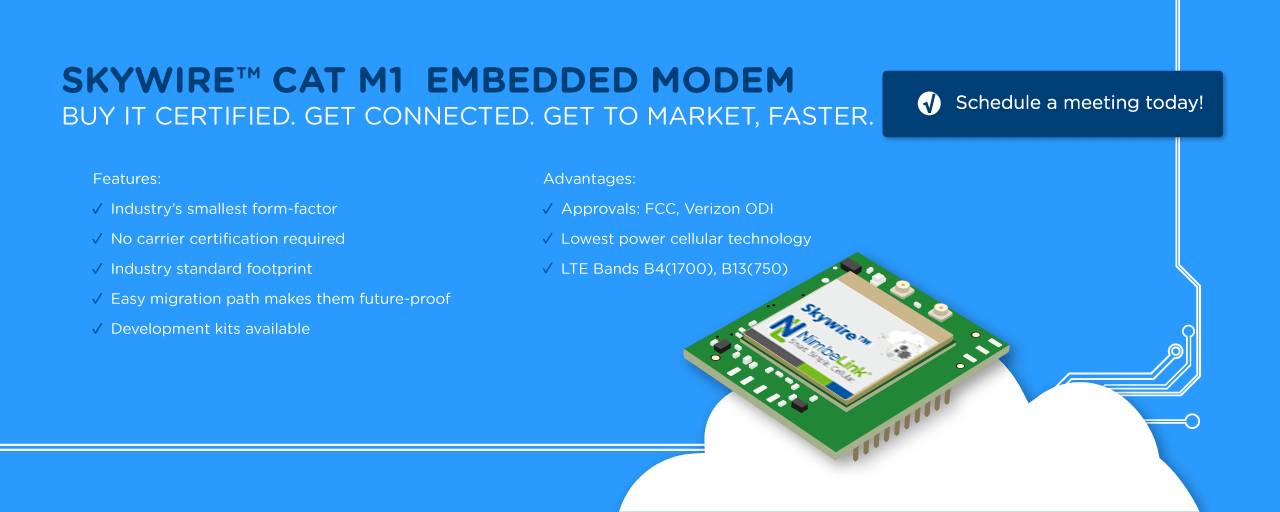- Home
- Symmetry Blog
- How LTE Cat M1 Saves Power and Money for the Internet of Things from Nimbelink
How LTE Cat M1 Saves Power and Money for the Internet of Things from Nimbelink
About Symmetry Electronics
Established in 1998, Symmetry Electronics, a Division of Braemac, is a global distributor of electronic components and systems. Combining premier components and comprehensive value-added services with an expert in-house engineering team, Symmetry supports engineers in the design, development, and deployment of a broad range of connected technologies.
Exponential Technology Group Member
Acquired by Berkshire Hathaway company TTI, Inc. in 2017, Symmetry Electronics is a proud Exponential Technology Group (XTG) member. A collection of specialty semiconductor distributors and engineering design firms, XTG stands alongside industry leaders TTI Inc., Mouser Electronics, and Sager Electronics. Together, we provide a united global supply chain solution with the shared mission of simplifying engineering, offering affordable technologies, and assisting engineers in accelerating time to market. For more information about XTG, visit www.xponentialgroup.com.
Internet of Things (IoT) applications can involve large numbers of devices, often in off-the-grid deployments. For that reason, any reduction in cost and power demand can be extremely significant, and LTE Category M1 can save plenty of both.
In order for the cellular modem’s power saving capabilities to be realized, they must be supported by both the module supplier and the service provider. NimbeLink modems are based on modules that provide full support for power-saving features. Service providers will be rolling out power-saving capabilities on their networks in sequence over time.
LTE Cat M1 power-saving features include:
- PSM (Power Saving Mode) – Traditional cellular modems often remain connected to the network and use significant amounts of power, despite being active, idle, or even in sleep mode. If disconnected from the network to save power, reconnection requires reboot and network search, which can take from 15 to 30 seconds in most cases. PSM lets the modem go into extreme low-power mode when not actively accessing the network, using minimum power and returning to full active state without requiring reboot or search.
- EDRX (Extended Discontinuous Receive) – Traditional cellular modems typically “check in” with the network at 1-second intervals. DRX or “Discontinuous Receive” lengthens the check-in interval to about 10 seconds. M1’s EDRX can lengthen the check-in interval up to 40 minutes, keeping the modem online but not checking in with the tower and enormously reducing power requirements.
- The Cat M1 specification allows an even lower transmit power than is used in the initial Cat M1 rollout. Initial transmit power is 23 dBm (decibels per milliwatt). The lower power in the spec is just 20 dBm. Because decibels is a logarithmic scale, this represents a huge reduction. It is important to note that this reduction in transmit power will not significantly reduce the modem’s range. This is because towers typically repeat sending each RF packet six to eight times to ensure reception in hard-to-reach areas. Cat M1 modems are able to stop receiving as soon as a packet is successfully received without having to listen to unnecessary repeats. (Under ideal conditions the M1 modem has a theoretical range of up to 62 miles.)
The costs of Cat M1 modems are loer because they are designed for applications using relatively little bandwidth and that transmit relatively infrequently. For those reasons the modems can use simpler, less expensive microcontrollers and RF transceivers and a reduced RF chain. Also, unlike other modems that typically require two antennas, Cat M1 requires just one. In addition to reducing the cost of the LTE Cat M1 modem itself, Cat M1 modems help reduce the cost, size, and complexity of devices in which they are deployed.
The ideal use case for the LTE Cat M1 modem is one in which it will send short messages at wide intervals. This makes it ideal for monitoring and reporting applications. Its low power requirement makes it well suited for remote, off-grid, or temporary deployments. In many applications, a Cat M1 modems can run for months or even multiple years on battery power. For those same reasons, applications that need greater bandwidth and that transmit frequently should use other types of 3G or LTE modems.
Source: http://nimbelink.com/blogs/lte-cat-m1-saves-power-money-internet-things/

